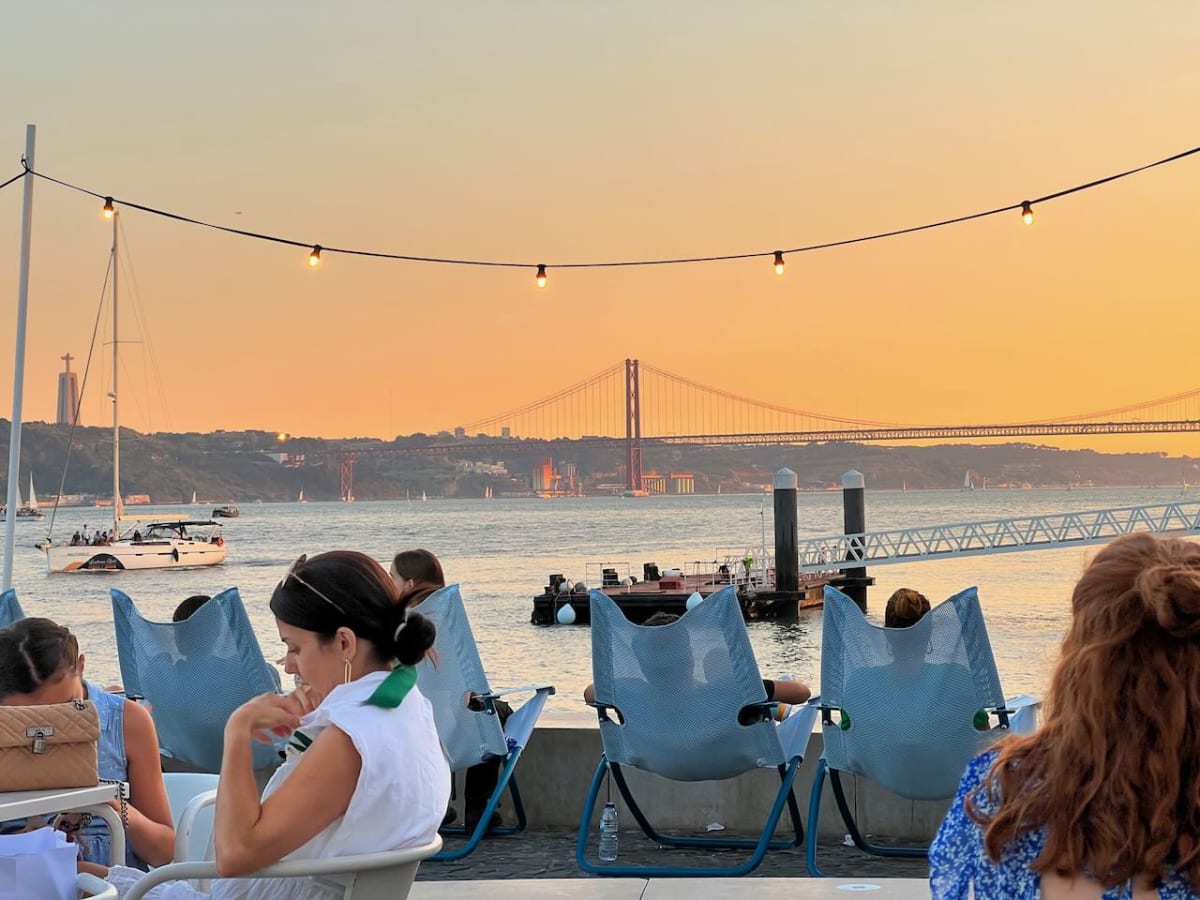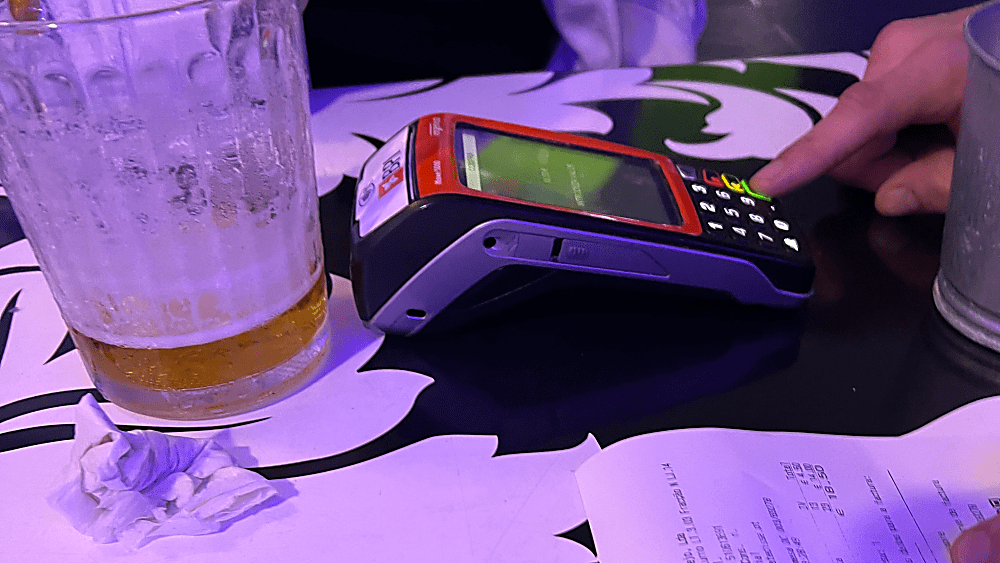Enjoying a beer in Portugal
Published
Living in PortugalfeaturedFind out how to order a beer in Portugal and other critical survival skills.

While wine is definitely the number one adult beverage in Portugal, people here still enjoy a nice cold beer on a hot day. However, there are many differences in beer culture between the US and Portugal. Here are a few tips to smooth out the differences, so you can enjoy a frosty pint in Portugal.
Having a beer in a bar, pub, or café
First, the bad news. If you are used to a massive variety of beer, you will be disappointed when trying to order a beer in a typical Portuguese café, pub, bar, or restaurant. In the States, most bars carry at least 8-10 different beers on tap. A couple of light beers, like Miller Lite, Coors Light, etc…, maybe a Guinness tap, two or three faux microbrews like Blue Moon, PBR and a couple of local IPAs. This is definitely not the case in Portugal.
Here, the beer scene is dominated by the two giant national beers; Superbock and Sagres. For most of the 20th century, the Portuguese beer industry was nationalized and protected from any form of foreign competition. By the 1990s, the two giant national beer companies were privatized, but they still control 90% of the domestic market. This influence goes well beyond what is available on tap; you see it in the branding on the mugs, chairs, and patio umbrellas. Recently, some foreign companies have established a foothold, most notably Heineken who now owns Sagres and Carlsberg, whose parent company also owns Superbock.
What does this all mean when you go out for a pint? It means your choices will be severely limited when compared to a visit to an American bar. With few exceptions, you’ll find that a bar or café will only really serve one brand of beer. Most will either be Sagres or Superbock establishments, with a few Heineken, Carlsberg and the occasional Estrella Damm bars available. All the tap options will belong to that one brewery, and if you want something else, you might find it in bottles only.
So, that’s the bad news. The good news is that the main brands in Portugal all make a very drinkable Pilsner style lager. If you’re looking for tasting notes and unlocking badges on the Untappd app, you’ll be very disappointed. But, if you want to enjoy a cold pint of lager in any number of amazing locations, Portugal may be the ideal location for you.
If you favor a specific brand of beer, be sure to watch for its logo on the chairs and umbrellas out front, as that’s likely to be your primary option. Once you’ve sat down, your main choice is likely what size to order. Most places will have a menu with the few other beer options, but your main choices for a draft beer size are:
- The Imperial. In the Porto area, you might see this size called the “fino”. This is a 20cl glass of beer, or about 6.8 US fluid ounces. It is not uncommon to find an imperial for €1.00, which helps explain their popularity. Also, small beers are less likely to be warm towards the end, and the smaller beers help regulate your drinking.
- At the other end of the spectrum you’ll find the mighty caneca. This 50cl mug holds about 17 US fluid ounces. This size tends to be more common in tourist areas, where Americans and Brits in particular enjoy a larger beer. In the Lisbon area, you can find a caneca of Superbock or Sagres ranging in price from €3.50 to €6.00 or more in highly touristic areas.
- Every so often you find a third option, the “tulipa” which is typically a 30cl glass, or about 10 US fluid ounces.
No matter the size, you can count on getting an icy beer, frequently in a frosty glass or mug.
When visiting at a pub or café, you will typically seat yourself, and a member of staff will usually bring a food menu and a drink menu for the table to share. After you place your initial order, the staff will generally leave you alone to enjoy your beer and food at your pace. I’ve never felt rushed at a Portuguese bar, café or restaurant, unlike in the States where it seems the waiter wants to bring the check within minutes of delivering the food and first drink. I greatly prefer the Portuguese way, but do remember that you will need to flag down your server to re-order. Typically, staff will hover off to the side, waiting for someone to catch their attention for a reorder.
When it comes time to pay, most places take card or electronic payment. Handheld, portable point-of-sale terminals seem to be everywhere in Portugal now. These terminals work fine with American Visa and Mastercard cards, as well as contactless payment methods like Apple Pay. Good old cash (Euros, of course) works just as well. Be sure to let the server know if you plan to pay by card, so they can bring the POS terminal to your table.

Tipping is always a fun topic for us Americans and can get people pretty wound up. For what it’s worth, here’s my approach. Tipping in never expected by often appreciated. If you appreciated the service, round up larger bills to the nearest 5 or 10 euro mark, or leave two or three euros. If your party has more than three or four people, bump up that amount. When it comes to actually leaving the tip, be sure to have some euro coins on you. When paying by card, you won’t be given the chance to add the tip to the bill like you are in the States. And even if you did find a way to add it to your card payment, I worry that the tip would actually make it to the staff. I find it best to leave a few Euros on the table after we settle the bill. Also, don’t make a show of it.
Buying beer at the grocery store
Buying beer at a grocery store in Portugal is a quite unfamiliar experience than you’re probably used to in the States, where you will often find a massive range of options, all in vast refrigerated cases. Even small grocery stores and convenience stores still offer dozens of brands and varieties, ranging from 6-pack bottles to 30-packs of cans.

Here in Portugal, things are quite a bit different. First, you will not find vast refrigerated beer sections. In fact, the only time I’ve ever seen cold beer in any store has been single cans from small refrigerated cases near the check stands, in case you want a cold one while out and about. I’ve never seen a cold multipack of beer.
Next, Portuguese seem to favor bottled beer over canned beer. In this regard, you will find a lot of variety, with bottle sizes ranging from 25cl (approximately 8 ounces) minis all the way up to 1 liter bottles. The 25cl mini seems particularly popular, and can be found in 6, 10, 15, 20, 24 and 30 bottle packs. You also have plenty of options for the 33cl (almost 12 ounces) bottle size.
If you prefer a can of beer, your options are much more limited. Canned beer in Portugal comes in 33cl and 50cl can sizes. Want to pick up a 6-pack of canned beer? Good luck, only a couple of brands sell 6-pack cans, and as far as I know, Sagres is the only option if you want a 12-pack of canned beer. Apart from the singles, everything is sold at room temperature.
Just like the bars and cafés, the beer aisle in the grocery store is dominated by the two national brands, Superbock and Sagres, with most of the shelf space going to the standard lager in various bottle and can sizes. Looking for an import or microbrew? Don’t get your hopes up beyond a Carlsberg or Heineken. Larger stores may have a few more options, but tend to use the larger beer aisle to stock even more cases of Sagres and Superbock.
FAQs
Does Portugal have open container laws?
I’m no expert in Portuguese licensing laws, but from what I’ve seen, there appears to be a very low entry barrier to selling beer and other adult beverages in Portugal. As a result, you might get the impression that any place could be a bar. Moreover, Portugal doesn’t seem to have any open container laws, though this could vary by locale. This really opens up the options for where to have a beer.
Can I get non-alcoholic or gluten-free beer in Portugal?
Non-alcoholic beer is easy enough to find, just look for “Cerveja sem Álcool” on the label. Look for “Cerveja com Álcool” for traditional 5.2 to 5.4 percent alcohol beer. Also note that if you’re used to Coors Light, Bud Light or Miller Lite, Sagres and Superbock both pack a bit more punch, with 15-20% more alcohol by volume, so pace yourself!
When it comes to gluten-free beer, I’ve never seen one in a bar or in a store in Portugal. They might exist, but gluten-free beer seems very rare. If you have a larger Continente or Pingo Doce nearby, you might find Super Bock's Cerveja com Álcool sem Glúten 6-packs.
Can I get a hard cider or hard seltzer in Portugal?
Thanks to all the UK tourists and expats, cider is definitely a thing in Portugal, and Somersby seems very popular and widely available. I have seen some hard seltzer in Portugal both at bars and in stores, but it still isn’t very common, and seems a bit pricey relative to other options.
What about wine or cocktails?
I might be the least qualified adult in Portugal to speak about wine, but I do know the Portuguese people really like wine, and are superb at making and drinking wine. Portugal has a significant wine culture that dates back millennia, and boasts several wine-growing regions. Even more impressive? How the Portuguese people drink wine. Per person, Portugal is the number one wine drinking country in the world, and it really isn’t that close, with France and Italy fighting it out for a distant second place. Wine is seemingly everywhere in Portugal. Even small grocery stores will still boast a strong selection of wines, with many at very compelling prices. If you like wine, Portugal might be the best country in the world for wine drinkers.
The Portuguese also seem to really enjoy a nice cocktail or mixed drink, too. You might struggle to find a place that doesn’t have either a caipirinha or mojito on the menu. Both drinks are great on a hot day, too. Beyond these two staples, you can expect to find a wind ranged of cocktails and mixed drinks even at more modest bars and restaurants. The best caipirinha I had was at a food truck in Nazaré.



